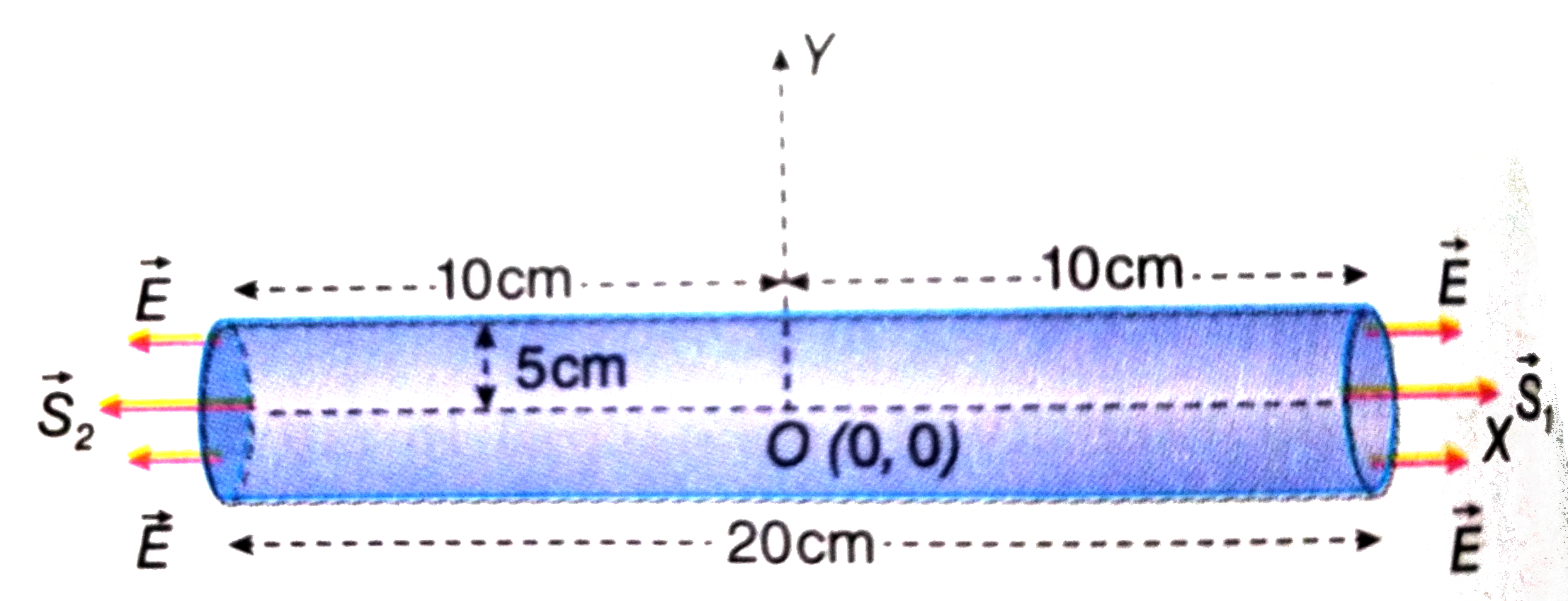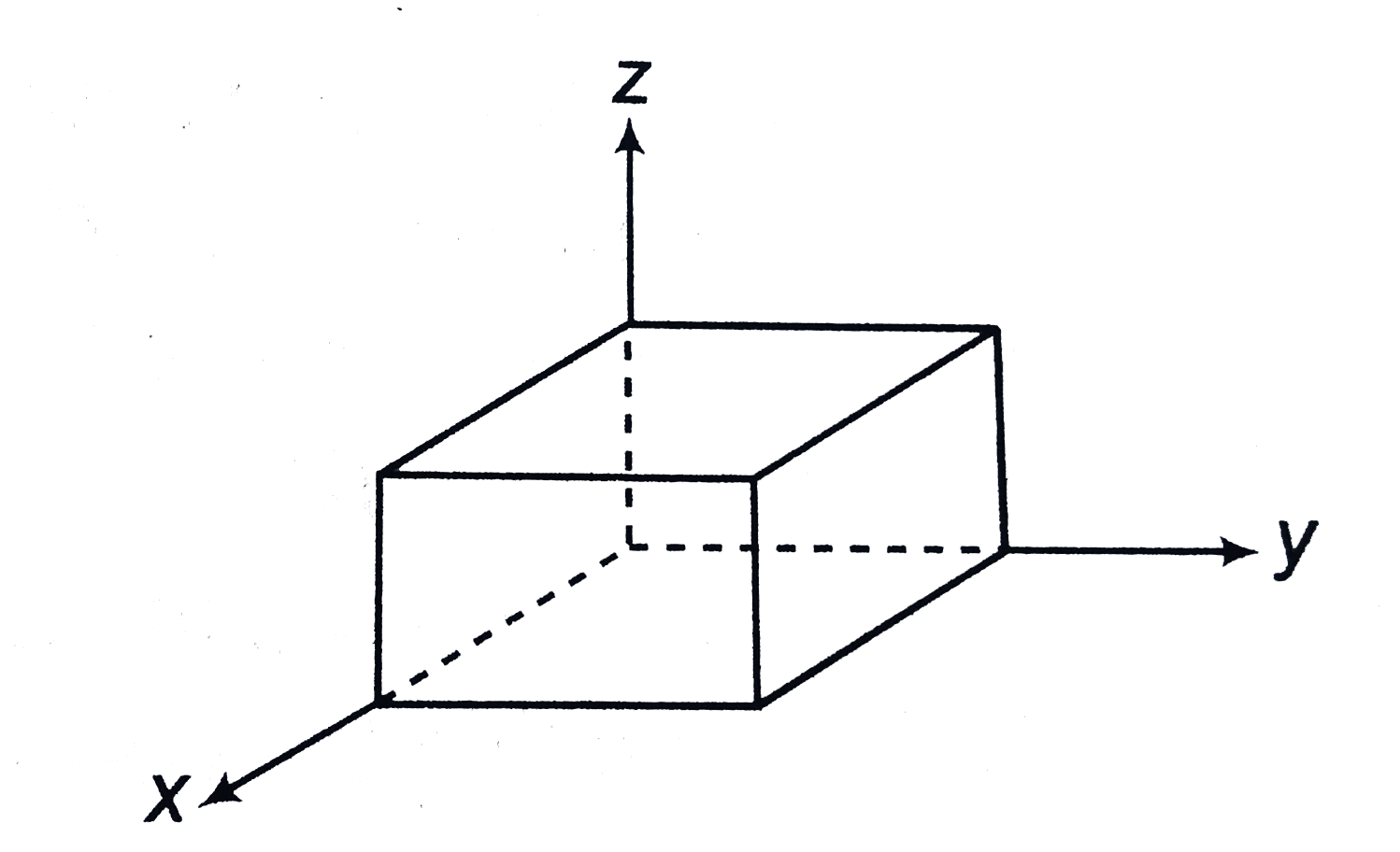A uniform electric field along the x - axis is given as,
, for
for
A cylinder of length 20 cm and radius 5 cm has its centre at the origin and axis along the x - axis is placed in vacuum. find out (i) the electric flux across each of its circular faces, (ii) the flux across its curved surface, (iii) the flux across its centre outer surface and (iv) the net charge enclosed by it.
Radius of the cylinder,
Area of each circular face,

As the length of the cylinder is 20 cm or 0.2 m, the two circular faces are at .
The area vectors representing the right and the left circular faces are respectively.
the electric fields at the positions of these circular faces are, respectively.
(i) The electric flux across the right circular face,
Similarly, for the left circular face,
i.e., equal flux passes across each of the two faces.
(ii) The curved surface is everywhere parallel to the electric field vector.
The electric flux linked with the curved surface = 0 therefore phi = phi _ 1 + phi _ 2 + 0 = 1.57 + 1.57 + 0 = 3.14 N * m^ 2 * C ^( - 1 ) phi = ( q ) /( in _ 0 ) q = phi in _ 0 = 3.14 xx 8.854 xx 10 ^( - 12 ) = 2.78 xx 10 ^( -11 ) C
Topper's Solved these Questions
- ELECTRIC FIELDBOOK - CHHAYA PUBLICATIONCHAPTER - ELECTRIC FIELDEXERCISE - SECTION RELATION QUESTIONS
50 Videos
- ELECTRIC FIELDBOOK - CHHAYA PUBLICATIONCHAPTER - ELECTRIC FIELDEXERCISE - HIGHER ORDER THINKING SKILL QUESTIONS
33 Videos
- ELECTRIC ENERGY AND POWERBOOK - CHHAYA PUBLICATIONCHAPTER - ELECTRIC ENERGY AND POWEREXERCISE - CBSE SCANNER
7 Videos
- ELECTRIC POTENTIAL BOOK - CHHAYA PUBLICATIONCHAPTER - ELECTRIC POTENTIAL EXERCISE - CBSE Scanner
13 Videos
Similar Questions
A cylinder of length L and radius b has its axis coincident with x-axis. The electric field in this region is →E=200ˆi. Find the flux through the left end of the cylinder.
View SolutionAn electric field is uniform and in the positive x direction for positive x and uniform with the same magnitude but in the negative x direction for negative x. It is given that E=200ˆiN/C for x>0 and E=−200ˆiN/C for x<0. A right circular cylinder of length 20 cm and radius 5 cm has its centre at the origin and its axis along the x-axis so that one face is at x=+10 cm and the other is at x=−10 cm
What is the net outward flux through each flat face?
View Solution
Knowledge Check
A cylinder of length L and radius b has its axis coincident with x-axis. The electric field in this region is →E=200ˆi. Find the flux through the left end of the cylinder.
A0B200πb2C100πb2D−200πb2A cylinder of length L and radius b has its axis coincident with the x-axis. The electric field in the region →E=200ˆi. Find the flux through (i) the left end of cylinder (ii) the right end of cylinder (iii) the cylinder curved surface, (iv) the closed surface area of the cylinder .
A(i) −100πb2(ii)100πb2(iii)50πb2(iv)50πb2B(i)−200πb2(ii)200πb2(iii)0(iv)0C(i)−100πb2(ii)100πb2(iii)100πb2(iv)100πb2D(i)−200πb2(ii)200πb2(iii)200πb2(iv)200πb2The electric field in a region is given by →E=200ˆiN/C for x>0 and −200ˆiN/C for x<0. A closed cylinder of length 2m and cross-section area 102m2 is kept in such a way that the axis of cylinder is along X-axis and its centre coincides with origin. The total charge inside the cylinder is (Take e0=8.25×10−12C2m2.N)
AzeroB1.86×10−5CC1.77×10−11CD35.4×10−8C
An electric field is uniform, and in the positive x-direction for positive x, and uniform with the same magnitude , but in the negative x-direction for negative x. It is given that
→E=200ˆiN/Cforx>0and→E=−200ˆiN/C for x gt 0. A right circular cylinder of length 20 cm and raidus 5cm has its center at the origin and its axis along the x-axis so that one face is at x=+10cm and the other is at x=−10cm.
(a) What is the net outward flux through the side of the cylinder ? (b) What is the net outward flux through the cyclinder ? (c) what is net charge inside the cylinder ?
View SolutionAn electric field is uniform, and in the positive x-direction for positive x, and uniform with the same magnitude , but in the negative x-direction for negative x. It is given that
→E=200ˆiN/Cforx>0and→E=−200ˆiN/C for x gt 0. A right circular cylinder of length 20 cm and raidus 5cm has its center at the origin and its axis along the x-axis so that one face is at x=+10cm and the other is at x=−10cm.
(a) What is the net outward flux through the side of the cylinder ? (b) What is the net outward flux through the cyclinder ? (c) what is net charge inside the cylinder ?
View SolutionA cylinder of length L and radius b has its axis coincident with x-axis. The electric field in this region is →E=200ˆi. Find the flux through the left end of the cylinder.
View Solution(a) Using Gauss law, derive expression for electric field due to a spherical shell a uniform charge distribution σ and radius R at a point lying at a distance r from the centre of shell, such that
(i) O<r<R,and
(ii) r>R.
(b) An electric field is uniform and acts along +x direction in the region of positive x. It is also uniofrm with the same magnitude but acts in -x direction in the region of negative x. The value of the fleld is E= 200 N/C for x>0andE=−200N/C for x<0. A right circular cylinder of length 20 cm and radius 5 cm has its centre at the origin and its axis along the x-axis so that one flat face is at x =+ 10 cm and the other is at x=-10 cm.
Find :
(i) The net outward flux through the cylinder.
(ii) The net change present inside the cylinder.
View SolutionA cube has sides of length L=0.2m. It is placed with one corner at the origin as shown in figure. The electric field is uniform and given by E=(2.5N/C)ˆi−(4.2N/C)ˆj. Find the electric flux through the entire cube.

View Solution
